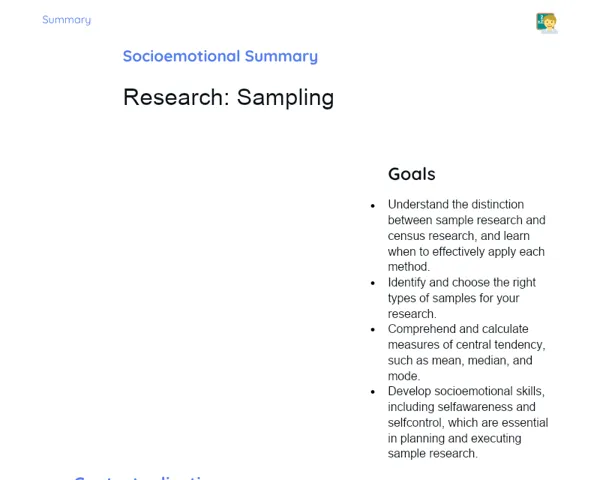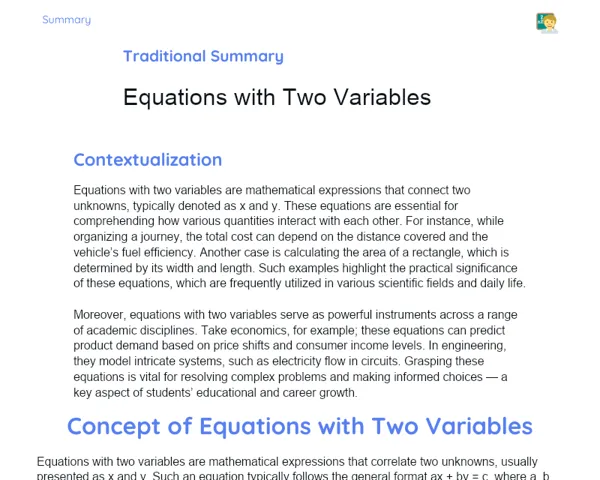Socioemotional Summary Conclusion
Goals
1. Grasp the idea of calculating the area of a trapezoid.
2. Learn and apply the trapezoid area formula.
3. Solve everyday problems – like planning a room layout or measuring a plot – using this formula.
4. Enhance socio-emotional skills such as self-awareness, self-control, and working well in teams.
Contextualization
Have you ever wondered how to measure a room or a piece of land that is not perfectly rectangular? Knowing how to calculate the area of a trapezoid is a very practical skill and can be very useful in real life. Whether you are involved in planning a small construction, arranging a community event, or even setting up a classroom, this knowledge comes in handy. Let’s begin this learning journey together and see how mathematics connects with our daily tasks!
Exercising Your Knowledge
Understanding the Trapezoid
A trapezoid, in simple terms, is a four-sided figure that has two sides parallel to each other, known as the bases. The other two sides are not parallel and are often called the lateral sides. Grasping this structure is crucial when it comes to computing its area for various practical uses.
-
Larger Base and Smaller Base: The bases are the parallel sides, where one is longer (the Larger Base) and the other is shorter (the Smaller Base).
-
Non-Parallel Sides: These sides connect the bases and also influence the overall shape.
-
Height: The height is the perpendicular distance between the two bases; it plays an essential role in calculating the area.
Trapezoid Area Formula
The basic formula for finding the area of a trapezoid is A = ((B + b) * h) / 2. Here, 'A' is the area, 'B' represents the larger base, 'b' the smaller base, and 'h' the height. Getting comfortable with this formula helps in applying it effectively to everyday scenarios.
-
Sum of the Bases: Start by adding the Larger Base (B) and the Smaller Base (b).
-
Multiply by Height: Next, multiply the sum by the height (h).
-
Divide by 2: Finally, divide the product by 2 to obtain the area.
Real-Life Applications
Calculating the area of a trapezoid is often useful in daily contexts, such as estimating the space for a plot of land or designing a room layout. These are real-life examples where mathematics makes decision-making informed and responsible.
-
Land Measurement: It is valuable in both urban planning and agriculture when measuring areas with unconventional shapes.
-
Event Planning: Determining the available space in venues is essential for organizing events.
-
Boosting Confidence: Applying these calculations in practical situations can raise your self-assurance and enhance mathematical skills.
Key Terms
-
Trapezoid: A four-sided figure with two parallel sides.
-
Larger Base: The longer pair of parallel sides in the trapezoid.
-
Smaller Base: The shorter parallel side in the trapezoid.
-
Height: The perpendicular distance between the two bases.
-
Area: The measure of the space enclosed within a figure.
For Reflection
-
How did you feel working on group problem-solving? What emotions came up and how did you manage them?
-
Can you think of a situation in your everyday life where you might use the trapezoid area calculation? Share an example.
-
What strategies did you use to manage your emotions during the lesson, and how did they help you stay focused and calm?
Important Conclusions
-
Understanding how to calculate the area of a trapezoid can help solve practical problems encountered in everyday life.
-
Learning the formula A = ((B + b) * h) / 2 is key to dealing with unconventional shapes in measurement tasks.
-
Applying this knowledge in real-world scenarios, such as measuring land, reinforces our confidence and competence in mathematics.
-
Developing socio-emotional skills like self-awareness and teamwork is vital for both personal growth and academic success.
Impacts on Society
The ability to calculate the area of a trapezoid directly benefits various fields like engineering, architecture, and urban planning. Whether you’re measuring a plot for construction or setting up spaces for community events, this skill is invaluable in today’s world. Additionally, mastering such mathematical concepts can open doors to future career opportunities and personal projects. On the emotional front, applying math in practical situations can greatly boost your self-confidence and sense of achievement, transforming a challenging subject into a useful tool for informed decision-making.
Dealing with Emotions
To help manage your emotions while studying, try using the RULER method. Begin by Recognizing the feelings that surface during problem-solving. Ask yourself, 'How do I feel when I face a challenging problem or work in a group?' Next, Understand why you feel that way and how it affects your work. Label your emotions clearly – be it frustration, anxiety, or contentment. Express your feelings appropriately by discussing them with peers or jotting them down. Finally, work on Regulating these emotions by practising deep breathing, taking short breaks, and reaffirming positive thoughts to stay calm and focused.
Study Tips
-
Practice calculating the area of a trapezoid with diverse problems and examples to strengthen your understanding.
-
Form study groups to discuss and solve problems together. Collaborative learning often makes the process both fun and more effective.
-
Use technology such as educational apps and geometry simulators to visualize trapezoids and experiment with measurements. These interactive tools can make the learning process more engaging.



